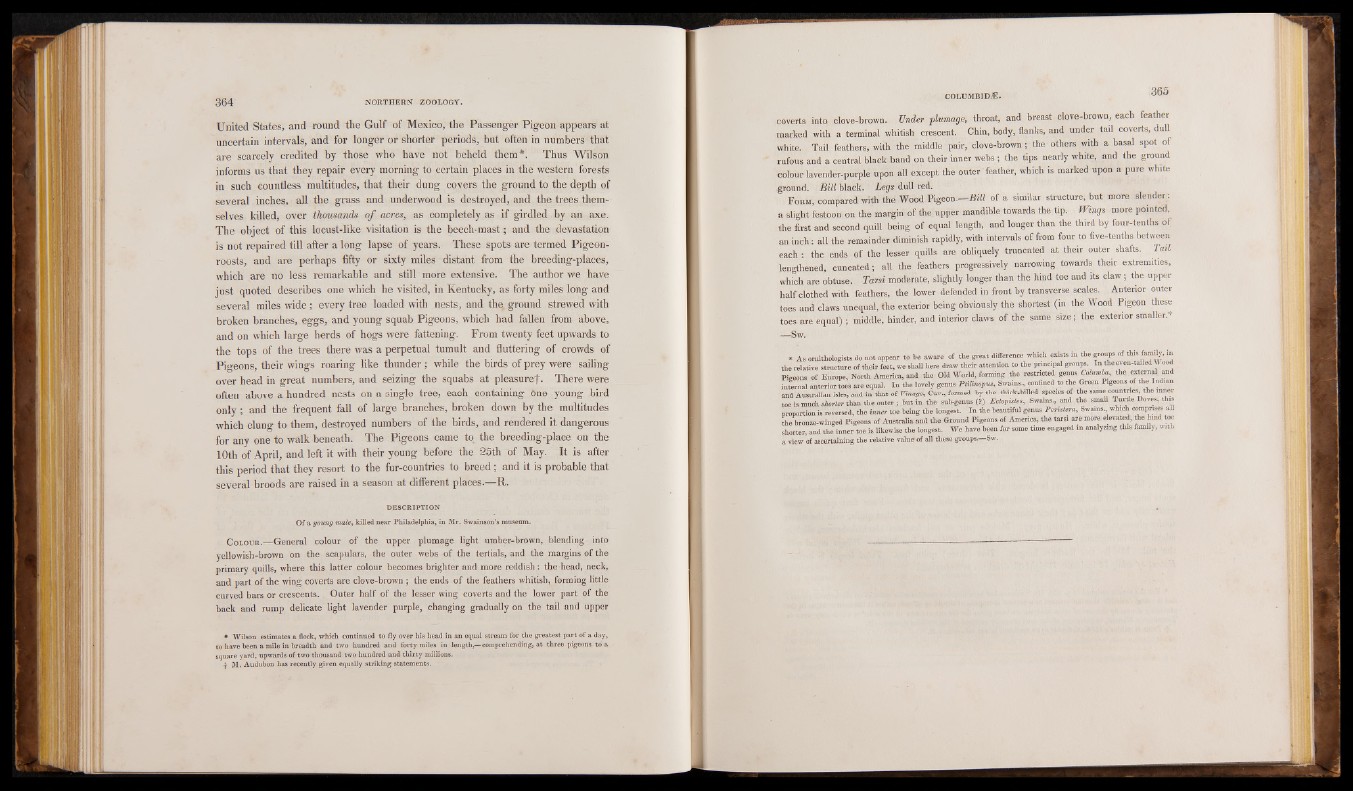
United States, and round the Gulf of Mexico, the Passenger Pigeon appears at
uncertain intervals, and for longer or shorter periods, but often in numbers that
are scarcely credited by those who have not beheld them*. Thus Wilson
informs us that they repair every morning to certain places in the western forests
in such countless multitudes, that their dung covers the ground to the depth of
several inches, all the grass and underwood is destroyed, and the trees themselves
killed, over thousands o f acres, as completely as if girdled by an axe.
The object of this locust-like visitation is the beech-mast; and the devastation
is not repaired till after a long lapse of years. These spots are termed Pigeon-
roosts, and are perhaps fifty or sixty miles distant from the breeding-places,
which are no less remarkable and still more extensive. The author we have
just quoted describes one which he visited, in Kentucky, as forty miles long and
several miles wide ; every tree loaded with nests, and the, ground strewed with
broken branches, eggs, and young squab Pigeons, which had fallen from above,
and on which large herds of hogs were fattening. From twenty feet upwards to
the tops of the trees there was a perpetual tumult and fluttering of crowds of
Pigeons, their wings roaring like thunder ; while the birds of prey were sailing
over head in great numbers, and seizing the squabs at pleasuref- There were
often above a hundred nests on a single tree, each containing One young bird
only; and the frequent fall of large branches, broken down by the multitudes
which clung to them, destroyed numbers of the birds, and rendered it dangerous
for any one to walk beneath. The Pigeons came to the breeding-place on the
10th of April, and left it with their young before the 25th of May. It is after
this period that they resort to the fur-countries to breed ; and it is probable that
several broods are raised in a season at different places.—R.
DESCRIPTION
Of a yov/ng male, killed near Philadelphia, in Mr. Swainson’s museum.
C o l o u r .— General colour of the upper plumage light umber-brown, blending into
yellowish-brown on the scapulars, the outer webs of the tertials, and the margins of the
primary quills, where this latter colour becomes brighter and more reddish : the head, neck,
and part of the wing coverts are clove-brown ; the ends of the feathers whitish, forming little
curved bars or crescents. Outer half of the lesser wing coverts and the lower part of the
back and rump delicate light lavender purple, changing gradually on the tail and upper
* Wilson estimates a flock, which continued to fly over his head in an equal stream for the greatest part of a day,
to have been a mile in breadth and two hundred and forty miles in length,—comprehending, at three pigeons to a
square yard, upwards of two thousand two hundred and thirty millions.
| M. Audubon has recently given equally striking statements.
coverts into clove-brown. Under plumage, throat, and breast clove-brown, each feather
marked with a terminal whitish crescent. Chin, body, flanks, and under tail coverts, dull
white. Tail feathers, with the middle pair, clove-brown ; the others with a basal spot of
rufous and a central black band on their inner webs ; the tips nearly white, and the ground
colour lavender.purple upon all except the outer feather, which is marked upon a pure white
ground. BilTblack. Legs dull red.
F orm, compared with the Wood Pigeon.—Bill of a similar structure, but more slender.-,
a slight festoon on the margin of theiupper mandible towards the tip. Wings more pointed,
the first and second quill being of equal length, and longer than the third by four-tenths of
an inch: all the remainder diminish rapidly, with intervals of from four to five-tenths between
each -. the ends of the lesser quills are obliquely truncated at their outer shafts. Tail
lengthened, cuneated; all the feathers progressively narrowing towards their extremities,
which are obtuse. Tarsi moderate, slightly longer than the hind toe and its claw; the upper
half clothed with feathers, the lower defended in front by transverse scalps. Anterior outer
toes and claws unequal, the exterior being obviously the shortest-(in the Wood Pigeon these
toes are equal) j middle, hinder, and interior claws of the same size; the exterior smaller.*
—Sw.
» As ornithologists do not appear to be aware of the great difference which exists m the groups of this family, in
the relative structure of their feet, we shall here draw their attention to the principal groups. In the even-tailed Wood
Pigeons of Europe, North America, and the Old World, forming the restricted genus Coiumba, the external and
internal anterior toes are equal. In the lovely genus Ptilinopm, Swains., confined to the Green Pigeons of the Indian
and Australian isles, and in that of Vinago, Cuv., formed by the thick-billed species of the same countries, the inner
toe is much shorter than the outer ; hut in the sub-genus (?) Ectopistes, Swains, and the small Turtle Doves, this
proportion is reversed, the inner toe being the longest. In the beautiful genus PerUtera, Swams, which “ mpnses all
the bronze-winged Pigeons of Australia and the Ground Pigeons of America, the tarsi are more elevated, the hind toe
shorter, and the inner toe is likewise the longest. We have been for some time engaged in analyzing this family, with
a view of ascertaining the relative valuer of all these groups.—Sw.